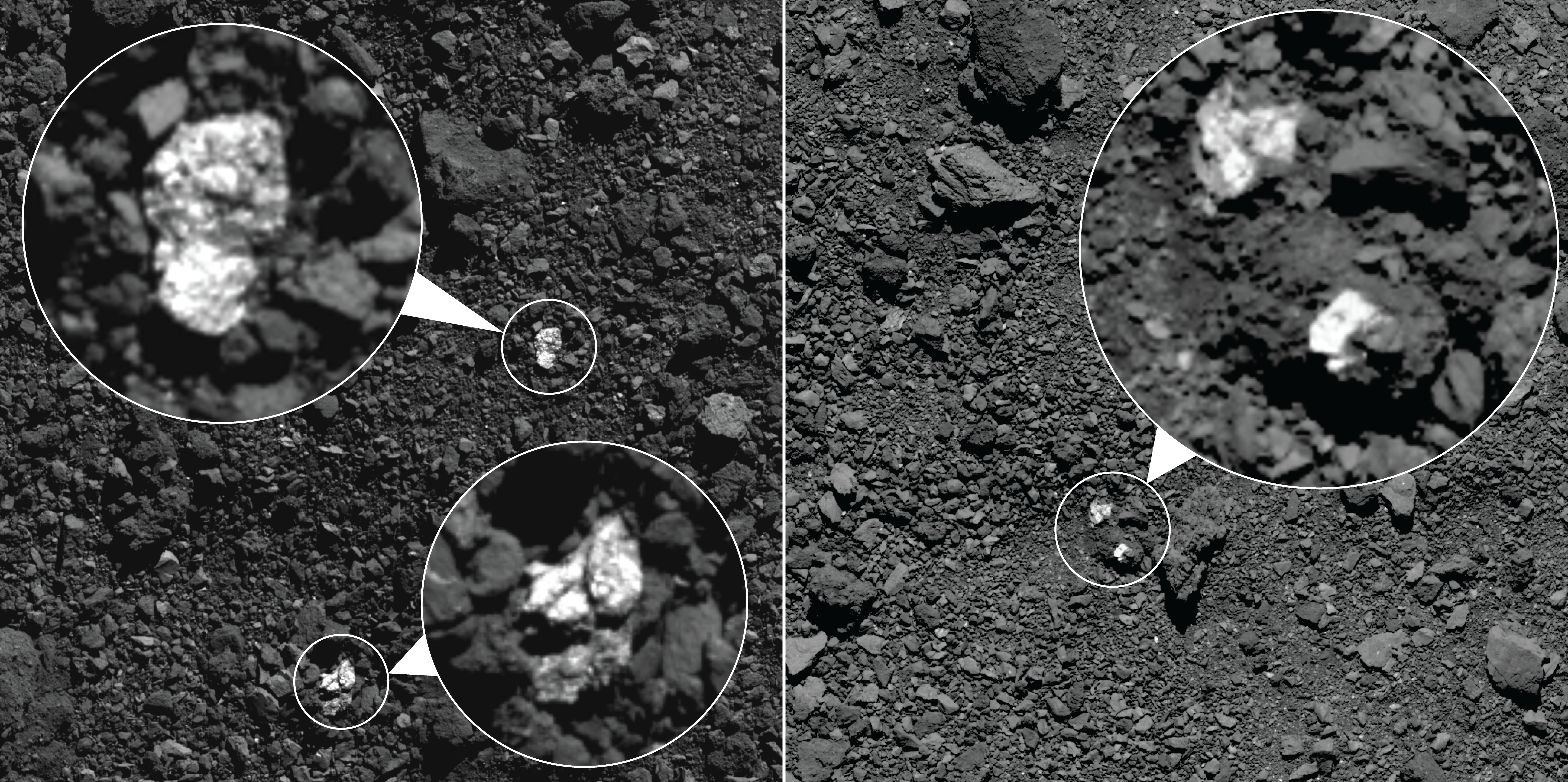Surprise! Asteroid Bennu sports pieces of another space rock
How'd that get there?
Pieces of the asteroid Vesta somehow made their way to a much smaller world, the space rock Bennu, which is currently hosting a NASA spacecraft.
Bennu's "rubble pile" appearance has puzzled scientists for nearly two years, since the 2018 arrival of NASA's OSIRIS-REx spacecraft, known formally as the Origins, Spectral Interpretation, Resource Identification, and Security-Regolith Explorer. The spacecraft will attempt to snatch a sample from Bennu in October and, if all goes according to plan, will deliver it on Earth in 2023 for more analysis.
Discovering several pieces of another asteroid on Bennu's surface gives scientists more clarity on how asteroids orbited in the solar system during our neighborhood's early history. The finding also reveals information about Bennu's violent past, when the asteroid formed from the pieces of a huge collision.
Related: OSIRIS-REx: NASA's Asteroid Sample-Return Mission in Pictures
NASA's Dawn spacecraft visited Vesta for 14 months in 2011 and 2012, and using data from this decade-old mission, scientists were able to easily match the boulders on Bennu with what they observed on Vesta.
"We found six boulders ranging in size from 5 to 14 feet — about 1.5 to 4.3 meters — scattered across Bennu's southern hemisphere and near the equator," Daniella DellaGiustina, a senior staff scientist at the University of Arizona, Tucson, said in a NASA statement. DellaGiustina is also the image processing lead scientist for OSIRIS-REx. "These boulders are much brighter than the rest of Bennu and match material from Vesta," DellaGiustina said.
Images from OSIRIS-REx showed bright boulders full of an igneous rock, called pyroxene, which is typical of rocks formed on Vesta. The rocks were up to 10 times brighter than their surroundings. Scientists studied the light reflected off the boulders using the spacecraft's visible and infrared spectrometer, which gave them a sense of the rocks' chemical composition.
Get the Space.com Newsletter
Breaking space news, the latest updates on rocket launches, skywatching events and more!
Bennu most likely acquired these oddball rocks from its parent asteroid, after a so-called "vestoid," a fragment from Vesta, struck the parent body, the research team suggested.
"When the parent asteroid was catastrophically disrupted, a portion of its debris accumulated under its own gravity into Bennu, including some of the pyroxene from Vesta," Hannah Kaplan, a research space scientist at NASA's Goddard Space Flight Center in Maryland, said in the same statement.
There are other possibilities for these rocks' origins. It is possible that the boulders were already on Bennu's parent asteroid, rather than Vesta. But pyroxene generally forms after rocky material melts at high temperature and Bennu is largely made of rocks with water-bearing minerals that could not have existed in such an environment.

"An impact needed to melt enough material to create large pyroxene boulders would be so significant that it would have destroyed Bennu's parent-body," NASA added in the statement. "So, the team ruled out these scenarios, and instead considered other pyroxene-rich asteroids that might have implanted this material to Bennu or its parent."
While spotting pieces of Vesta on Bennu sounds like hitting the cosmic lottery, it's actually not so unusual to see pieces of one asteroid on another's surface. Vesta's lighter crater walls sport strange dark material, there's a random black boulder on asteroid Itokawa and the otherwise carbonaceous Ryugu shows patches of material from siliceous asteroids.
What all this activity shows is that the orbits of asteroids change constantly as the pulls of planets and other objects change their paths in space. At times, this can cause space rocks to collide, as spacecraft are now seeing with various asteroids in the solar system.
Other studies suggest that, before it found its near-Earth orbit, Bennu used to be in the main asteroid belt between Mars and Jupiter. There are two families of asteroids in the inner main belt that have carbonaceous asteroids, similar to the composition of what Bennu's parent body would have been.
Scientists are curious as to why pieces of Vesta have shown up on Bennu, but why no other asteroid types have been found on Bennu. The vestoids likely came from the Veneneia and Rheasilvia impact basins on Vesta, which were carved out roughly 2 billion and 1 billion years ago, respectively.
"We look forward to the returned sample, [from Bennu] which hopefully contains pieces of these intriguing rock types," Dante Lauretta, OSIRIS-REx principal investigator at the University of Arizona in Tucson, said in the same statement.
Follow Elizabeth Howell on Twitter @howellspace. Follow us on Twitter @Spacedotcom and on Facebook.
Join our Space Forums to keep talking space on the latest missions, night sky and more! And if you have a news tip, correction or comment, let us know at: community@space.com.

Elizabeth Howell (she/her), Ph.D., was a staff writer in the spaceflight channel between 2022 and 2024 specializing in Canadian space news. She was contributing writer for Space.com for 10 years from 2012 to 2024. Elizabeth's reporting includes multiple exclusives with the White House, leading world coverage about a lost-and-found space tomato on the International Space Station, witnessing five human spaceflight launches on two continents, flying parabolic, working inside a spacesuit, and participating in a simulated Mars mission. Her latest book, "Why Am I Taller?" (ECW Press, 2022) is co-written with astronaut Dave Williams.









